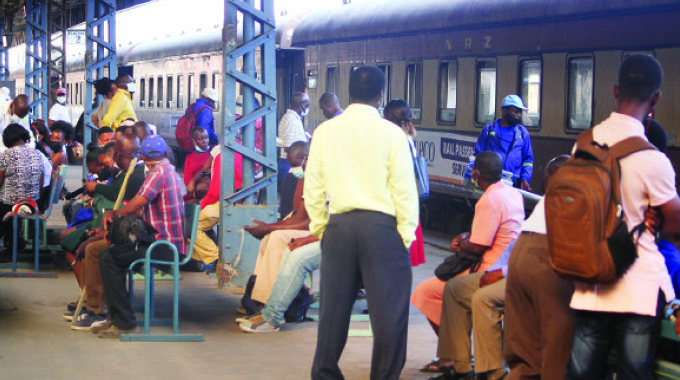EDITORIAL COMMENT: Keep on track with modernising railways

Plans to reintroduce intercity train services need to be moved forward more quickly, along with upgrading the rail system so that it can take over a far higher fraction of the cargo haulage.
At one stage the railways dominated both cargo and passenger traffic. In the 1960s and early 1970s, for example, when the population of Zimbabwe was round about 4 million people, the railways sold more than 4 million tickets in a year, which shows the sheer scale of the passenger operations.
Admittedly the railways were given a degree of protection. There were no intercity bus permits if the two cities or towns were linked by a railway line.
Bus companies were encouraged, but their routes had to start from a rail head and then handle the passenger traffic away from the railway network. This tended to encourage a larger number of smaller companies, as each could handle only a narrow fan of routes.
It took the liberation war to change the system and while passenger trains operated after independence their former dominance was gone as more and more traffic moved to buses.
Cargo was so dominated by the railway network that industry needed to be confined into the industrial sites, simply because of the siding structure.
To this day in industrial areas, or at least the older ones, there is this network of sidings, and sidings of sidings, because a factory needed to be able to bring a wagon to its boundary.
Now most of those sidings are overgrown with weeds, and the rusting rails choked with garbage, and we no longer see strings of wagons being shunted through the industrial areas, although the track network still exists.
Rail traffic, once the huge capital investment in the actual rail network and laying the track was done, was a lot cheaper than road transport.
A single locomotive could match the capacity of 30 very large trucks so the fuel for each kilometre-tonne was a lot less, and the manpower requirements were just two or three staff, instead of 30 drivers. Passenger traffic could be more comfortable. One reason why buses were able to snatch away ever more traffic was the rather peculiar class structure on railway services, a class structure largely built around race.
There were four classes, with the top two fairly similar and designed for whites, the fourth class with open carriages using wooden benches for blacks, and the third class with very crowded small compartments designed for the rest.
A major and long overdue attempt in the 1980s to rebuild the third and fourth class carriages as modern open carriages with vastly improved seating, something more like bus seating or better, did help hold the line, but carriages were becoming older, buses were becoming faster, and the pressure for continually upgrading passenger services simply was not there any more.
In some parts of the world rail has made a serious return to becoming a major component of public transport.
Besides modern designs of carriages with decent comfortable seating, but including dining cars and snack bars, there has also been the conversion of railways into faster transport systems.
Even without the specialised high-speed lines, the ones that can handle trains moving at exceptional speeds, normal track has been able to handle trains moving in the 150km/h to 200km/h range.
Unfortunately, in Southern Africa, and much of the rest of sub-Saharan Africa, we are limited to what is known as Cape gauge, 1,067m between the rails rather than the 1,435m standard gauge of much of the world’s high-speed railways, and even broader gauge in Russia and adjoining countries.
The narrow gauge was chosen to lessen the civil engineering works in much of the British empire in the 19th and early 20th centuries since curves could be tighter, but the net result is that speeds have to be lower as a result.
The old passenger railway timetables worked round this rather effectively, with many passenger trains between the larger cities being overnight trains.
Passengers would board their train, eat and then sleep, getting out at the destination city early the next morning. It was a bit rough on those booked for the intermediate smaller stops, having to disembark at say 2am, but it did minimise the inconvenience of the inherently slower speeds.
The vital point to note is that while night-time passenger traffic on roads is dangerous, on trains it is totally safe, and while sleeping in a car or bus is uncomfortable, sleeping on a train is a great way of passing a journey.
Goods trains were not really affected by the speeds, even if they did have to take a bit longer than a passenger train on single track working, when they were parked briefly in a siding to let the passenger train through, because the trains were not much slower than a truck on average. They were able to maintain a steady speed between stops for many kilometres. And the convenience in the end having the wagons for each business delivered to the back gate through the siding system, or collected when full from the back gate, was a huge attraction.
There are all sorts of reasons why the Zimbabwe rail network fell back. Partly it was a long series of negative feedback. Once lack of investment in new equipment started causing more delays, more traffic switched to road, both passenger and goods, and that meant that there was less money for railways investment and so more traffic switched and so on.
But the railways are there. There is some urgent maintenance required on a modest fraction of the track, but this is hardly rebuilding.
The present network connects all the cities and most of the larger towns, plus a decent percentage of the smaller towns, so passenger traffic is a viable option. Goods traffic sees, once garbage has been cleared and rail-crossings fixed up, a connection from the back doors of a lot of factory sites to the backdoors of a lot of others, plus backdoor to port connections.
What is required is the investment, largely into new rolling stock but also into modern signal and control technology; there are obvious ways satellite communications, the modern phone networks and ICT can be connected to the Victorian railway network to produce something very effective.
Some of this imagination and innovation is being seen in the plans for reintroducing intercity passenger traffic, using modern diesel-electric multiple units, each new and modern carriage having its own power supply and motors so no locomotive is needed, thus making trains extremely flexible by being able to add or subtract units to make up a train that fits the traffic, but still with just one crew for the whole lot.
The upgrade is needed on the commuter trains, since 1940s and 1950s rolling stock will not last forever, and the multiple units with their greater flexibility seem even more desirable on these routes.
Given the investment, given the modern technologies, given upgraded rolling stock, there is no reason why the railways cannot return to their glory days with something a lot better and able to compete with road transport by offering something better and more cost effective.









Comments